Rust Family Foundation: Archaeology Grants Program
Excavations at the Iron Age and Roman sanctuaries
at the Sources de l’Yonne agglomeration, Burgundy, France
Principal Investigator:
Dr. Tom Moore, Associate Professor of Archaeology, Durham University
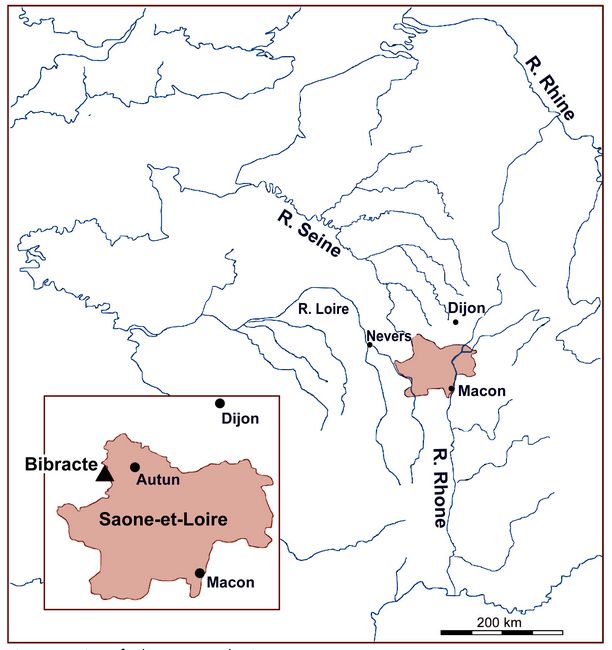
The current research project at the Late La Tène (Late Iron Age: 2nd - 1st century BCE) agglomeration of Sources de l’Yonne in the environs of the oppidum of Bibracte is focused on addressing issues regarding the nature of early urbanism in Europe. Through field research at one of the pre-eminent oppida in Europe, Bibracte (Burgundy, France: fig.1), this project is demonstrating that this proto-urban centre was far larger and less nucleated than previously imagined.
Fig.1: Location of Bibracte complex in France.
In particular, the discovery of a large, c. 120 hectare unenclosed settlement around the Sources de l’Yonne (a major tributary of the Seine), just 3km from occupation on Mont Beuvray (fig.2) and contemporary with it, is necessitating a re-evaluation of how we understand the Bibracte complex, and oppida in general (Moore 2017). The current project, w
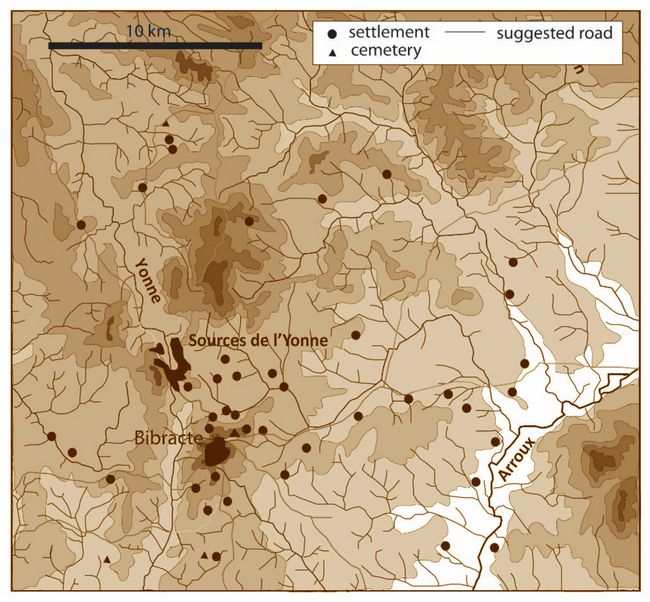 orking in conjuncture with the Bibracte EEPC,
Centre Archéologique Européen (CAE) (based at Glux-en-Glenne, Nièvre,
France) (www.bibracte.fr), is using targeted excavation and survey at
the location of the Gallo-Roman temple complex at the Sources de
l’Yonne site as part of examining how this large settlement emerged,
its role and how it relates to the better studied centre of occupation
on Mont Beuvray. A clearer understanding of the nature and role of
Sources de l’Yonne has the potential to radically alter our perceptions
of, not just Bibracte, but the nature of oppida in Late Iron Age Europe
generally (Moore 2017).
orking in conjuncture with the Bibracte EEPC,
Centre Archéologique Européen (CAE) (based at Glux-en-Glenne, Nièvre,
France) (www.bibracte.fr), is using targeted excavation and survey at
the location of the Gallo-Roman temple complex at the Sources de
l’Yonne site as part of examining how this large settlement emerged,
its role and how it relates to the better studied centre of occupation
on Mont Beuvray. A clearer understanding of the nature and role of
Sources de l’Yonne has the potential to radically alter our perceptions
of, not just Bibracte, but the nature of oppida in Late Iron Age Europe
generally (Moore 2017).Fig.2: Relationship between Sources de l’Yonne agglomeration and occupation on Mont Beuvray (Bibracte) (from Moore 2017).
Previous Work at the site:
The first two seasons of excavation at the Sources de l’Yonne temple complex (2016 & 2017) confirmed the presence of 3 Romano-Celtic type Gallo-Roman temples (Fanum I, II and III; fig.3). Excavation has focused in the area of Fanum I and III and has demonstrated that Late Iron Age occupation layers and structures exist beneath the Gallo-Roman temples (Moore and Hoppadietz 2016). Initial examination demonstrates that these have multiple phases, the latter of which date to the late 1st century BC. It appears from initial examination, however, that there are likely to be earlier phases of building beneath these.
In addition, circular features, seemingly votive pits were found central to both Fanum I and III, and appear to relate to the pre-Roman temple structures. Continued excavations aim primarily at determining the nature of these Late Iron Age structures, the role of circular pits within the area (fig.7), to assess if these had a ritual role, and assess whether they are indeed religious buildings.
Funded Research Project (RFF-2018-55)
Project goals:
.
With the above research questions in mind, the current project is focused on determining whether the Gallo-Roman temples at the site have Iron Age precursors. In order to do this, the current overall project aims are to:
1. Assess the state of preservation of the Gallo-Roman temples and the archaeological potential of the site.
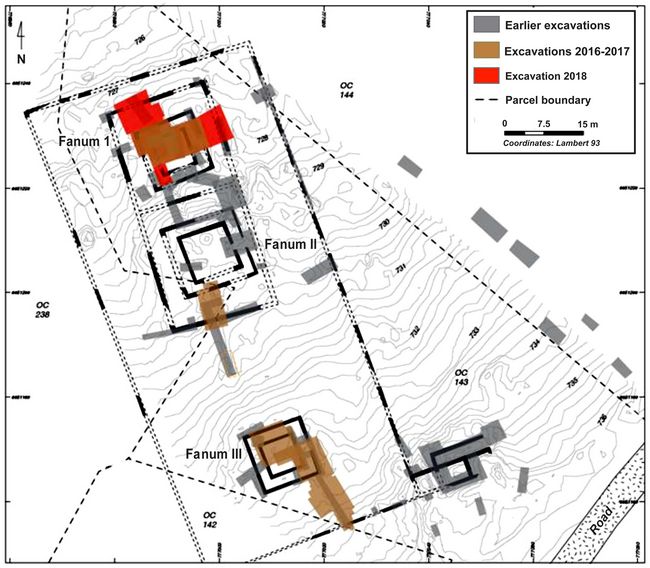
2. Assess the chronology of the Gallo-Roman temples and their relationship with the Late Iron Age settlement.
3. Confirm the presence of Late Iron Age occupation and activity beneath the Gallo-Roman temples.
4. Determine whether Iron Age activity represents evidence for pre-Roman sanctuaries.
5. Provide a structural sequence and refined dating of any Iron Age phases of activity encountered.
The 2018 season focused on establishing the nature of the Iron Age structures identified in 2017 and establish whether these were part of an earlier, Late Iron Age sanctuary.
Fig 3: Layout of Gallo-Roman temple complex, showing location of excavation areas in 2016-17 and 2018, as well as location of old sondages. The plan of the complex has been compiled from the location of walls in the recent and older excavations (A. Meunier).
Methodologies and findings:
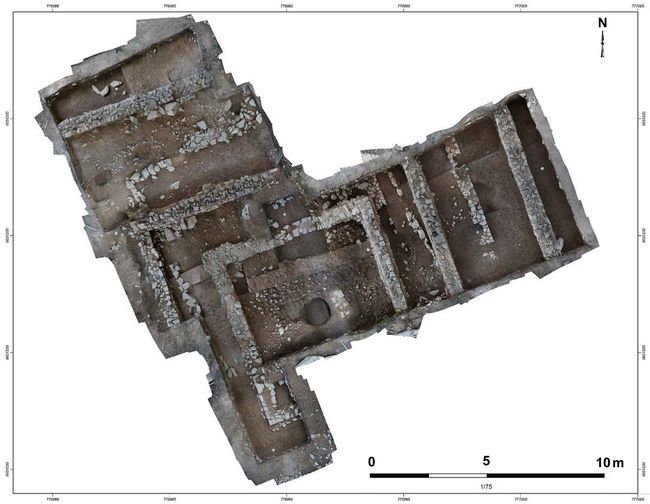 Excavations
at Sources de l’Yonne were conducted between June 10th and July 17th
2018 with a small team of 10 people (including staff from the UK,
France, Germany and USA). In 2018 the focus was on the area of Fanum I
(one of the three Gallo-Roman temples in the sanctuary complex: fig.
3). The 2017 investigation area, located around the Gallo-Roman Fanum
I, was extended (creating an excavation area of c. 177m2) to provide a
larger window in order to examine evidence of earlier structures
beneath the Roman temple (Fig. 4).
Excavations
at Sources de l’Yonne were conducted between June 10th and July 17th
2018 with a small team of 10 people (including staff from the UK,
France, Germany and USA). In 2018 the focus was on the area of Fanum I
(one of the three Gallo-Roman temples in the sanctuary complex: fig.
3). The 2017 investigation area, located around the Gallo-Roman Fanum
I, was extended (creating an excavation area of c. 177m2) to provide a
larger window in order to examine evidence of earlier structures
beneath the Roman temple (Fig. 4).Fig.4: Photo of excavation area revealed in 2018.
Excavations revealed that, beneath the Gallo-Roman fanum (temple), there were at least two phases of pre-Roman, Late Iron Age building dating to the
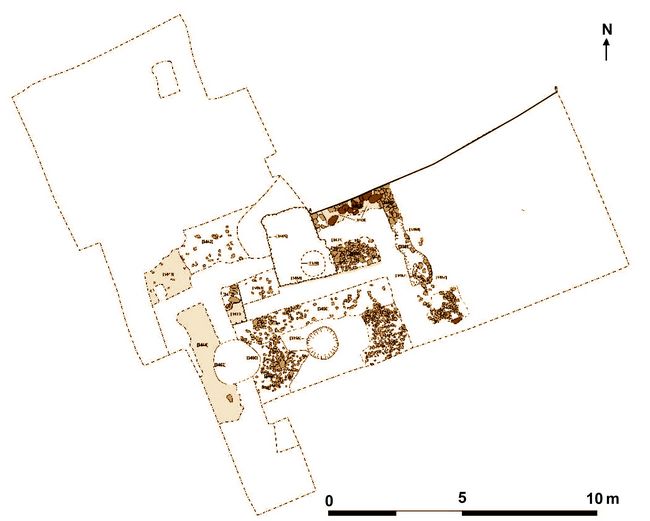 early-mid 1st
century BCE. Building 1 (fig.5), dating to La Tène D1b-La Tène D2a
(early 1st century BCE), was only partially revealed, but it is more
than likely that far more of this structure and perhaps earlier
structures extend beneath Building 2 in the unexcavated areas. What has
been uncovered so far, suggests the presence of a timber building
resting on shallow stone-wall footings, a similar construction
technique to on Mont Beuvray.
early-mid 1st
century BCE. Building 1 (fig.5), dating to La Tène D1b-La Tène D2a
(early 1st century BCE), was only partially revealed, but it is more
than likely that far more of this structure and perhaps earlier
structures extend beneath Building 2 in the unexcavated areas. What has
been uncovered so far, suggests the presence of a timber building
resting on shallow stone-wall footings, a similar construction
technique to on Mont Beuvray.Fig.5: Building 1, features and plan.
A second phase of building (2), on a different alignment was also confirmed. This marked a major transformation of the site (fig.6). It represents an entirely different building technique to Building 1 and one hard to parallel on Mont Beuvray itself. It represented a major
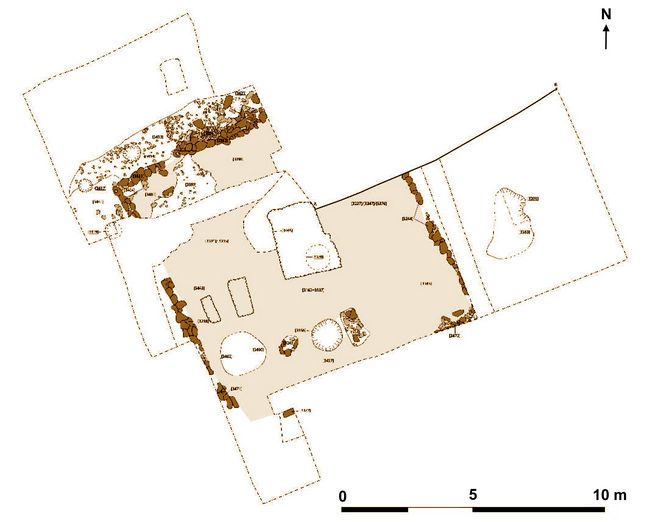 realignment of the building’s axis, pivoting it towards the north-west.
The structural form of Building 2 is somewhat enigmatic. The stone
walls are significantly different from the wall foundations identified
for Building 1. These relatively rough alignments of stones are more
similar to the coarser wall constructions identified in some places on
the terraces to the south of the temples (e.g. Péquinot et al. 1996;
Moore et al. 2011, 430).
realignment of the building’s axis, pivoting it towards the north-west.
The structural form of Building 2 is somewhat enigmatic. The stone
walls are significantly different from the wall foundations identified
for Building 1. These relatively rough alignments of stones are more
similar to the coarser wall constructions identified in some places on
the terraces to the south of the temples (e.g. Péquinot et al. 1996;
Moore et al. 2011, 430).Fig.6: Building 2, features and plan.
The relatively fragile nature of the clay floor surfaces within these alignments suggests it is unlikely that they represented an unroofed area, howe
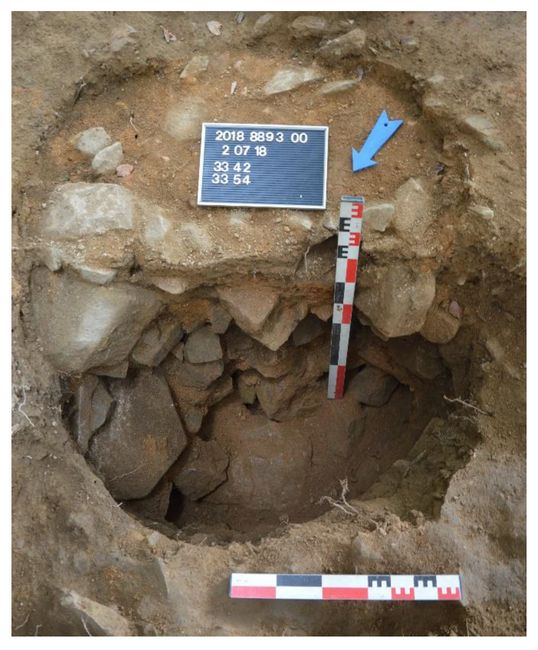 ver, as does the presence of small amount of tegula, which
implies it had a tiled roof. The level surface of these stones,
embedded in the clay floor surfaces, suggests instead they were
foundations for a timber super-structure. The identification of a row
of postholes to the north of these walls seems to suggest it also had
some sort of portico, perhaps redolent of the early phase timber
structures identified at PC14 on Mont Beuvary (cf. Barral et al. 2017).
ver, as does the presence of small amount of tegula, which
implies it had a tiled roof. The level surface of these stones,
embedded in the clay floor surfaces, suggests instead they were
foundations for a timber super-structure. The identification of a row
of postholes to the north of these walls seems to suggest it also had
some sort of portico, perhaps redolent of the early phase timber
structures identified at PC14 on Mont Beuvary (cf. Barral et al. 2017).Fig.7: Large pit [3356] within Building 2, later filled by rubble as foundation for podium at centre of Gallo-Roman temple.
A large pit (fig.7) discovered located to the rear of Building 2 seems to have been the focus of activity. Its function, as a receptacle for libations or offerings can only be presumed with any such material presumably removed when it was backfilled for the foundation of a podium when the Gallo-Roman temple was constructed (see below).
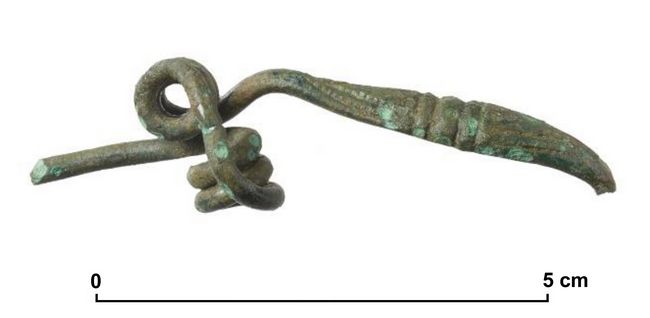
The construction of Building 2, took place in La Tène D2a (Mid-1st century BCE). The sequence of floor surfaces associated within Building 2 indicates that it had, at least, two major structural phases with the presence of Augustan coins from the uppermost floor surfaces, recovered in 2017 and 2018, related to the second phase.
Fig.8: Duchov brooch (4th century BCE) found in foundation of Late Iron Age Building 2.
Artefacts from the deposits associated with Building 2 were relatively rich, including most notably an exceptional find of a bronze Duchcov type brooch, originating in Bohemia, dating to La Tène B1 (4th century BCE) (Fig. 8), far earlier than the temple floor deposit, and one of the earliest ever found within the Bibracte complex. The twisted nature of the brooch pin strongly suggests this was a votive offering, po
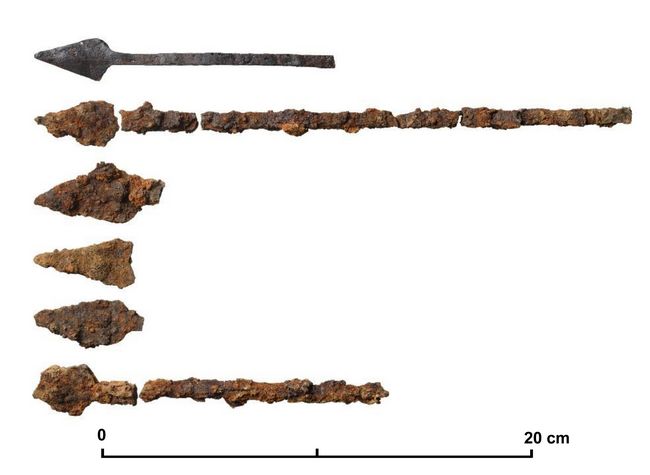 ssibly
deposited deliberately as part of the foundation deposits for the
second Iron Age building. Its early date may suggest, however, that an
even earlier ritual structure remains to be discovered below the Late
Iron Age levels. Also interesting were a range of pointed iron objects
which were associated with Building 2 (fig.9). Comparable objects have
been identified on Mont Beuvray, where they were identified as ‘pila’.
Such identification seems unlikely, however, and their function is a
mystery – that they had some form of ritual function cannot be ruled
out.
ssibly
deposited deliberately as part of the foundation deposits for the
second Iron Age building. Its early date may suggest, however, that an
even earlier ritual structure remains to be discovered below the Late
Iron Age levels. Also interesting were a range of pointed iron objects
which were associated with Building 2 (fig.9). Comparable objects have
been identified on Mont Beuvray, where they were identified as ‘pila’.
Such identification seems unlikely, however, and their function is a
mystery – that they had some form of ritual function cannot be ruled
out.Fig.9: Iron objects of uncertain function found in floor levels of Building 2 and foundation of Gallo-Roman temple. Possibly some sort of ritual implement (the top example is a comparative items from excavation on Mont Beuvray: see Moore and Hoppadietz 2018).
The stoned-wall, Gallo-Roman Fanum I replaced Building 2, returning the structure to a similar alignment to Building 2 (fig.10). There appears to have been direct continuity between the Phase 2 building’s demolition and construction of the Fanum. The gravelly material used as bedding for the Fanum I hérisson was laid directly onto layers of burnt material from the destruction of Building 2. It appears that the central pit located in Building 2 was chosen as the focus for Fanum I, being filled with rubble stones and mortar as foundation for a podium, presumably for a statue. It is notable that the footprint of Fanum I is similar in scale to that of Building 2 also suggesting a close connection between to two structure. Despite these indications of continuity, the change in alignment suggests that continuity of the building’s orientation was not deemed important. Alternatively, this
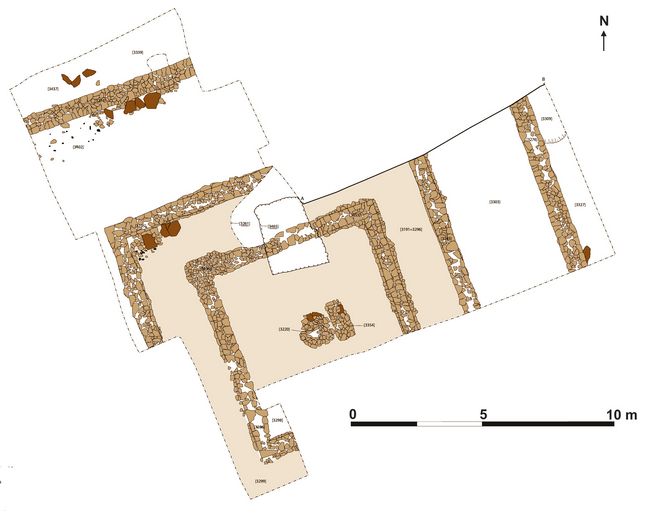 realignment was deemed necessary to reinforce the terrace on which
these buildings stood. All of the temples at Sources de l’Yonne are
constructed on terraces built on the relatively steep slopes of La
Grand Vente. There is evidence from the Gallo-Roman phase of building
that the Fanum I temenos wall collapsed at some point and was rebuilt, indicating the somewhat unstable nature of some of the terrace
foundations.
realignment was deemed necessary to reinforce the terrace on which
these buildings stood. All of the temples at Sources de l’Yonne are
constructed on terraces built on the relatively steep slopes of La
Grand Vente. There is evidence from the Gallo-Roman phase of building
that the Fanum I temenos wall collapsed at some point and was rebuilt, indicating the somewhat unstable nature of some of the terrace
foundations.Fig.10: Plan of Gallo-Roman temple (Fanum I).
Dating evidence for the construction of Fanum I indicates it was probably built in the Augustan or Tiberian era. This corresponds with the dating evidence obtained for the construction of Fanum III (Moore and Hoppadietz 2017), suggesting they were constructed concurrently. It seems likely they represented a wholesale reorganisation of the complex with the Sources de l’Yonne laid out at the same time (Moore and Hoppadietz 2017). An early 1st century CE date for construction of Fanum I reflects a broader pattern, recognised in central-eastern Gaul, of the rebuilding and remodelling, often in masonry, of sanctuaries at this time (e.g. Hostein et al 2014). How long Fanum I was in use is difficult to establish. The lack of later Roman material is not e
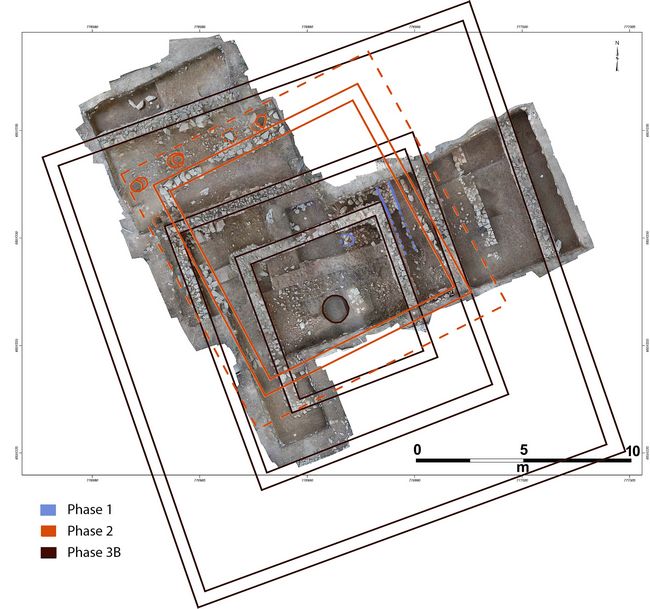 specially diagnostic, with many temples of this era seemingly kept
relatively clean (Pierre Nouvel pers. comm.). Dating of the tegula from
the 2016 and 2017 excavations (Delencre et al. 2017), alongside the
presence of occasional later finds in the 1980s material (see Moore and
Hoppadietz 2016), indicates that the Fana probably remained in use into
at least the 2nd /3rd century CE, and perhaps later. Evidence for stone
robbing and possibly the removal of the roof (indicated by the
relatively limited amount of tegula associated with Fanum I), suggests
that, when they were abandoned, the Fana were systemically demolished.
specially diagnostic, with many temples of this era seemingly kept
relatively clean (Pierre Nouvel pers. comm.). Dating of the tegula from
the 2016 and 2017 excavations (Delencre et al. 2017), alongside the
presence of occasional later finds in the 1980s material (see Moore and
Hoppadietz 2016), indicates that the Fana probably remained in use into
at least the 2nd /3rd century CE, and perhaps later. Evidence for stone
robbing and possibly the removal of the roof (indicated by the
relatively limited amount of tegula associated with Fanum I), suggests
that, when they were abandoned, the Fana were systemically demolished.Fig.11: Sequence of buildings in the area of Fanum I at Sources de l’Yonne.
Conclusions:
The identification of multiple phases of building beneath the Gallo-Roman Fanum I emphasises the long and complex history to occupation at the Sources de l’Yonne (fig.11). There is sufficient evidence that these earlier structures are likely to have been ritual in nature and that the Gallo-Roman complex replaced a pre-existing Iron Age sanctuary. The lack of hiatus between occupation phases and location of Fanum I in close relationship to the earlier buildings both imply a continuity of ritual function. Meanwhile the placement of Fanum I centred on the pit from earlier Building 2 suggests this remained the focal point for ritual activity. Similar sequences of activity can be attested to at both Fanum I and Fanum III: both provide evidence of pre-Fanum buildings which were focused around pits which were backfilled on the construction of a stone Romano-Celtic temple. This similarity suggests that the whole Sources de l’Yonne complex underwent a process of redevelopment in the Augustan-Tiberian era. It even seems to suggest that an arrangement of multiple sanctuary buildings existed in the Late Iron Age, prior to the construction of the Fana.
The chronology of the earliest phases of activity beneath Fanum I remains somewhat uncertain but activity commenced at least as early as La Tène D1b (early 1st century BCE). The possibility, raised for example by the discovery of a La Tène B1 (4th century BCE) brooch, of even earlier activity remains, however, and it is worth remembering that none of the areas investigated at Sources de l’Yonne, either at the temples or on the terraces (Moore et al. 2013), are likely to have revealed the very earliest phases of occupation. The development of Building 2, probably in La Tène D2a and use into the Augustan period corresponds well with evidence from elsewhere within the Sources de l’Yonne complex of a flourish of activity at this time (Moore et al 2013) coeval with that on Mont Beuvray itself. As with the sanctuaries on Mont Beuvray, it seems that whilst the settlement was largely abandoned in the Augustan-Tiberian era the sanctuary was redeveloped and continued as an important place in the landscape.
Combined with investigations undertaken elsewhere in the Sources de l’Yonne complex (Moore et al 2013), these excavations provide new insights into the nature of this agglomeration. There is increasing evidence that the Gallo-Roman temple complex represented continuity from a pre-existing Late La Tène sanctuary that was contemporary with the settlement located on the terraces on La Grand Vente and Mont Prenley around the source of the river Yonne. The multiple roles for Late La Tène unenclosed agglomerations, as centres for artisans, trade and settlement are well known, but these excavations suggest the source of the Yonne river also represented an important, pre-Roman ritual focus. This evidence increasingly points us to the possibility that the sanctuary might have been the stimulus for the agglomeration’s emergence, as appears to have been the case at other unenclosed agglomerations in Gaul (Barral and Nouvel 2012) . Do the hints of even earlier activity suggest that this location may pre-date activity on Mont Beuvray? Evidence from other Late Iron Age sanctuaries in Gaul suggests many emerged much earlier in the 4th-3rd century BC (Brunaux 1988) and it is always possible this was the case here. Future work will need to explore, in more detail, the nature and chronology of the earliest phases of activity at the site to address these issues.
Overall, the current funded project (RFF-2018-55) allowed a small team to undertaken a relatively large excavation as well as retrieve micro-morphological samples and soil samples for further scientific analysis and material for radiocarbon dating which will provide further insights into the chronology and nature of activity at the Sources de l’Yonne sanctuary. It has enabled the archaeological investigation at Sources de l’Yonne to continue to challenge orthodox perspectives on Late Iron Age urban centres in Gaul with the complex increasingly comparable in scale and development to its more famous neighbour on Mont Beuvray. It emphasises the importance of detailed survey and excavation within the immediate environs of the recognised ‘oppida’ in order to understand their place in worldwide proto-urban development.
Ongoing plans, including final publication
The immediate next stage of work is to complete full post-excavation assessment, including a detailed micromorphological analysis of the nature of the surfaces encountered within Building 2. It is hoped that this will allow for a better understanding of the sequence and nature of these floor levels. In addition, other specialist reports on the environmental remains and radiocarbon dating of the earliest levels are likely to provide further insights into the nature and date of activities.
Excavation at the complex has temporarily ceased in order to complete full post-excavation and publication of the previous work undertaken at Sources de l’Yonne between 2007-2018. This will be published in English (with summaries in French and German) as a monograph via the CAE Bibracte monograph series (http://www.bibracte.fr/fr/approfondir/ ressources-documentaires/ les-publications_1) . Once this is complete, provisional agreement has been reached with the CAE to undertake a larger-scale excavation of the now recognised Late Iron Age sanctuary complex at Sources de l’Yonne. This will aim to establish its full extent and reveal whether it has earlier origins in the Middle La Tène. It is expected that this will be combined with further excavations within the wider 120ha agglomerated settlement to better determine if the entire complex had a similar chronological trajectory.
__________________________________________________________________________
References:
Barral, Nouvel 2012 : BARRAL (P.) NOUVEL (P.) La dynamique d’urbanisation à la fin de l’âge du Fer dans le centre-est de la France. In SIEVERS (S.) & SCHONFEDER, (M.) (eds.) Die Frage der Protourbanisation in der Eisenzeit/ La question de la proto-urbanisation à l’âge du Fer Actes du 34ème colloque de l’AFEAF, Aschaffenburg, 24-26 mai 2010. Bonn: Dr. Rudolf Habelt GmbH, p. 139-164.
Barral et al. 2017: BARRAL (P.) NOUVEL (P.), THIVET (M.) La Terrasse PC15 (intervention 861). GUICHARD (V.) (ed.) Programme quadriennal de recherche 2017-2020 sur le Mont Beuvray. Rapport intermédiaire 2017 (Synthèse). Glux-en-Glenne : Bibracte, 2017, p. 208-269.
Brunaux 1988. BRUNAX (J-L.) The Celtic Gauls: gods, rites and sanctuaries. Seaby: London.
Delencre et al. 2017 : DELENCRE (F.), GRADELER (M.) and GARCIA (J-P.) Les matériaux de construction gallo-romains des temples des Sources de l’Yonne. In:
GUICHARD (V.) (ed.) Programme quadriennal de recherche 2017-2020 sur le Mont Beuvray. Rapport intermédiaire 2017 (Synthèse). Glux-en-Glenne : Bibracte, 2017, p.129-158
Hostein et al. 2014 : HOSTEIN (A.), JOLY (M.), KASPRZYK (M.), NOUVEL (P.) Sanctuaires et pratiques religieuses du III e s. au V e s. apr. J.-C. dans le Centre-Est de la Gaule (Lugdunensis I et Maxima Sequanorum) in LA FIN DES DIEUX : Les lieux de culte du polythéisme dans la pratique religieuse du IIIe au Ve s. apr. J.-C. (Gaules et provinces occidentales). Gallia 71(1) : 187-218
Moore 2017: MOORE (T.) Alternatives to urbanism? Reconsidering oppida and the urban question in Late Iron Age Europe. Journal of World Prehistory 30(3): 281-300.
Moore, Hoppadietz 2016 : MOORE (T.), HOPPADIETZ (R.). Le sanctuaire des Sources de l’Yonne. In : BIBRACTE, Programme quadriennal de recherche 2013-2016 sur le Mont Beuvray, Rapport annuel 2016. Glux-en-Glenne : Bibracte, 2016, p. 251-270
Moore, Hoppadietz 2017 : MOORE (T.), HOPPADIETZ (R.). Le sanctuaire des Sources de l’Yonne (intervention 862). GUICHARD (V.) (ed.) Programme quadriennal de recherche 2017-2020 sur le Mont Beuvray. Rapport intermédiaire 2017 (Synthèse). Glux-en-Glenne : Bibracte, 2017, p. 308-324.
Moore, Hoppadietz 2018 : Moore T,), Hoppadietz (R.). Le sanctuaire des Sources de l’Yonne. In: Vincent Guichard (Hrsg.), Rapport intermédiaire 2018 du programme quadriennal de recherche 2017-2020 sur le Mont-Beuvrax. (Glux-en-Glenne, Bibracte. 2018), p. 291-317.
Moore et al. 2011 : MOORE (T.), CRIPPS (L.), KLENNER (I.), BRAUN (A.). Sondages aux Sources de l’Yonne. In : BIBRACTE, programme de recherches sur le Mont Beuvray. Rapport annuel 2011, rapport triennal 2009-2011. Glux-en-Glenne : Bibracte, 2011, p. 557-586.
Moore et al. 2013 : MOORE (T.) BRAUN (A.) CREIGHTON (J.) CRIPPS (L.), HAUPT (P.), KLENNER (I.), NOUVEL (P.), PONROY (C.), SCHÖNFELDER (M.). Oppida, Agglomerations, and Suburbia : the Bibracte Environs and New Perspectives on Late Iron Age Urbanism in Central-eastern France. European Journal of Archaeology, 16, 2013, p. 491-517.
Péquinot et al. 1996 : PEQUINOT (CL.), PICARD (G.), PASQUET (A.), FISCHER, (B.), MEISSONNIER, (J.). — Le sanctuaire des sources de l’Yonne, commune de Glux - Nièvre. Revue Archéologique de l’Est, 47, 1996, p. 209-231.
Recent Foundation grants: general Archaeology Grants Program w/map
Copyright © 2019 Rust Family Foundation